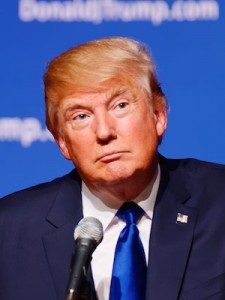 Donald J. Trump, the 45th President of the United States (POTUS), managed to get elected based at least in part on his real or perceived success as a businessman. In the last dozen years or so, he achieved this reputation in part by licensing his “Trump” brand name—a kind of intellectual property (IP)—to third parties.
Donald J. Trump, the 45th President of the United States (POTUS), managed to get elected based at least in part on his real or perceived success as a businessman. In the last dozen years or so, he achieved this reputation in part by licensing his “Trump” brand name—a kind of intellectual property (IP)—to third parties.
And like many things Trumpian, the truth behind POTUS IP success remains elusive, at best, or illusory, at worst. So in order to help illuminate the topic, I contacted a number of IP legal experts and other business professionals to give their input and best estimates as to what reality shows about how ‘The Donald’ does IP.
Impossible to Determine How Much Trump Licensing Income
What remains plain upon examination of Trump’s public financial disclosures—what few exist—is that licensing revenue intertwines with other sources in a series of Gordian knots, according to legal experts who have looked at the records. For example, the president and his Trump Organization commonly commingle income from branding with sources such as inbound interest payments.
“Careful analysis of President Trump’s election financial disclosure forms makes clear he is involved in a lot of businesses and opportunities—167 to be exact,” according to Robert Morris, member, and Michael Jones, associate, Eckert Seamans Cherin & Mellott, a full-service national law firm. “Of these 167 sources of income, 26 relate in part to licensing agreements. For every asset that lists ‘license deal’ as a portion of income, Trump also lists bank accounts, royalties and management fees as other potential sources of income within the same assets. Combining each asset with multiple avenues of income within the asset makes it impossible to determine licensing income with any specificity.”
But while Trump and his organization have made good use of the lawful options for hiding definitive evidence of how to value these branding deals in many circumstances, a few glimmers have shined out of the haze over the years from unimpeachable sources. For example, the licensing agreement for Trump Tower Tampa became public in a lawsuit, which initially licensed “Trump Tower” for $2 million.
“It may come as a surprise to most people that many of Trump’s buildings, resorts and golf clubs aren’t even owned by him,” says Sonia Lakhany, trademark attorney and owner, Lakhany Law, PC, a national award-winning trademark law firm. “They just bear his name for branding purposes. In return, Trump collects fees for the use of his brand, without ever investing a dime into the actual projects.”
And per their final assessment, Morris and Jones conclude that Trump does not make most of his money from licensing. See Donald Trump’s Income Sources.
Trump Brand Valuation: a Number out of ‘Thin Air’
When Trump began running for president in 2015, numbers were published pegging various of his assets with certain valuations. Of these, one of the more speculative remains the dollar value for the Trump brand name, according to IP portfolio experts.
“If we go by the most commonly understood definition of value—i.e., current fair market value—the value of $3.3 billion for Trump’s brand is very likely hyped,” says Bharat Ramnani, head of practice, valuation advisory, Aranca, a custom research, analytics and advisory partner to businesses.
The way Ramnani sees it, how Trump values his brand remains an exercise in storytelling. Additional data and clarity about how the Trump brand generates economic profits would be necessary for a more compelling estimate of the value, according to Ramnani.
“Trump’s estimate of $3.3 billion of his brand at the time of the presidential campaign was no more than pulling a number from thin air,” Ramnani says.
Reality Shows Trump Brand Licensing by the Numbers
And with the hype surrounding the Trump brand valuation, reasonable observers may have preconceived notions about the level of deal-making The Donald has achieved in IP licensing. According to the experts, there remain two primary methods of looking at this concept. First, consider the deal count with third parties willing to pay cash on the barrel head for rights to the Trump name. Second, look at the self-dealing Trump has done to put his moniker on properties, goods and services that he sells directly.
“Trump has been very active in licensing in two ways,” says Jed Ferdinand, founder and senior managing partner, Ferdinand IP, a boutique law firm for all facets of intellectual property, licensing corporate law and litigation. “First, licensing his name for development of properties, such as hotels and golf courses, for many years. Then Trump’s business model changed from owning properties to licensing his name on properties owned by others—classic brand licensing. Many publications report Trump owns very few properties at this point. Of the 20-odd properties in New York that bear his name, he owns closer to five of them. This is true nationwide and worldwide.”
And according to an Aranca analysis of publicly available property licensing and joint development deals currently in effect, Trump has 18 branding agreements and 14 joint development projects. That would strike many as a moderate balance.
According to the Washington Post, Trump’s real estate dealings are scattered across the globe and the majority of his international projects have been licensing deals.
“Most interesting—and likely in our view—is that emerging markets are where the Trump brand may capture the bulk of brand licensing deals,” Ramnani says. “India particularly stands out in this group (with seven Trump brand licenses). Not only does India account for the most Trump-branded real estate projects outside of the United States and Canada but also—going by media reports—Trump Organization seems extremely bullish on the India market.”
While achieving at least a certain level of success with real estate IP licensing, Trump’s other branding ventures may not have achieved that amount of certitude. Ramnani questions if the Trump brand can be effective in sectors other than real estate, golf courses and hotels—or even golf merchandise. And even more mundane products? At this point, what customer would have security in the Trump brand name, some intellectual property legal experts seem to ask.
“When was the last time you purchased a Trump steak or Trump water?,” asks Roberta Jacobs-Meadway, Esq., co-chair, intellectual property group, Eckert Seamans Cherin & Mellott. “When was the first time? How many people really purchased Trump ties? Other than his daughter’s Ivanka Trump brand, when was the last time you saw an advertisement for any Trump-branded apparel? Until Trump’s presidential candidacy with its high level of media visibility—pro and con—the licensing program for goods was not particularly subject to bad publicity. These ventures were launched with much publicity but appear to have fizzled out quietly, despite seeming continued success of the brand for some real estate and hospitality ventures.”
In the end, the lesson for wannabe lifestyle entrepreneurs remains that brand licensing programs must be well thought out, well managed and consistent with the image of the licensor—whatever that may be—according to Jacobs-Meadway. For example, Trump currently has 309 active applications and registrations for marks with the USPTO and 336 expired, abandoned or canceled marks that contain the Trump name, according to Eckert Seamans research. Is that a case of a well-thought licensing plan? Or a lot of thought then second thought?
IP Licensing as a Business Strategy?
Clearly, as the forgoing legal analysts have opined from their informed perspectives and the facts—to which no alternative exists—Trump has met with mixed success in his IP licensing business strategy. An array of real estate assets bear his name and bring in some level of revenue but not enough to rank as the top three individual sources of income. And Trump’s foray into product licensing looks like a series of projects that came a cropper except for Ivanka Trump’s brand of consumer goods. But does that mean that really serious image-conscious and conscientious licensors cannot make big bank with a third-party IP strategy? And even Trump might have realized this wisdom belatedly only lending his name—not actual capital—to sometimes risky commercial endeavors.
“Managing a brand through licensing is a ‘business’ and those who want to license their brand must be willing to put resources behind it,” says Katherine Bows Taylor, marketing, communications and branding consultant, K.B. Taylor Marketing. “If successful, what you reap in terms of licensing fees can more than offset cost of your licensing program. Trump figured that out and got out of development and more into the management side. It’s much easier to license your name to other developers than to be involved in the development.”
However, licensing your brand name doe not mean “set it and forget it” then just let the cash flow in. With experience overseeing the Georgia Institute of Technology licensing program, Taylor knows brand management never ends. According to her, setting up and managing a licensing program takes time and resources—and good legal counsel.
“Enforcement is ongoing, making sure licensees use your brand according to established guidelines,” Taylor says. “Then there is ongoing monitoring to ensure that only those who paid licensing fees use your brand.”
UPDATED March 9, 2017 at 11:10am ET. During final edits the conclusion reached by Morris and Jones was unintentionally altered. It is their conclusion that President Trump does NOT receive the majority of his money from licensing.

![[IPWatchdog Logo]](https://ipwatchdog.com/wp-content/themes/IPWatchdog%20-%202023/assets/images/temp/logo-small@2x.png)

![[Advertisement]](https://ipwatchdog.com/wp-content/uploads/2024/04/Patent-Litigation-Masters-2024-sidebar-early-bird-ends-Apr-21-last-chance-700x500-1.jpg)

![[Advertisement]](https://ipwatchdog.com/wp-content/uploads/2021/12/WEBINAR-336-x-280-px.png)
![[Advertisement]](https://ipwatchdog.com/wp-content/uploads/2021/12/2021-Patent-Practice-on-Demand-recorded-Feb-2021-336-x-280.jpg)
![[Advertisement]](https://ipwatchdog.com/wp-content/uploads/2021/12/Ad-4-The-Invent-Patent-System™.png)







Join the Discussion
No comments yet.